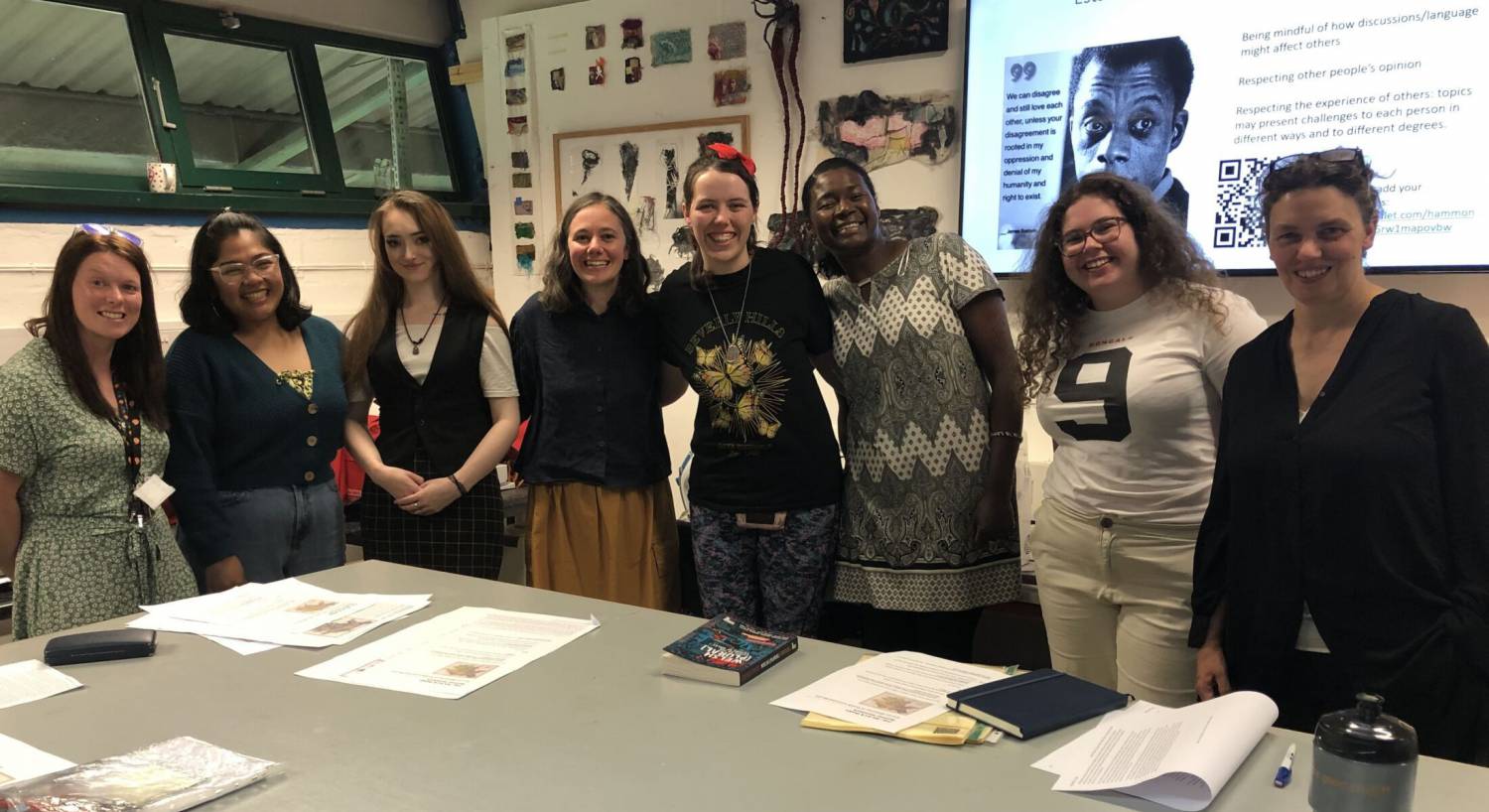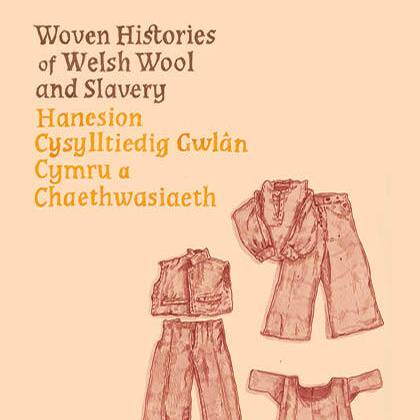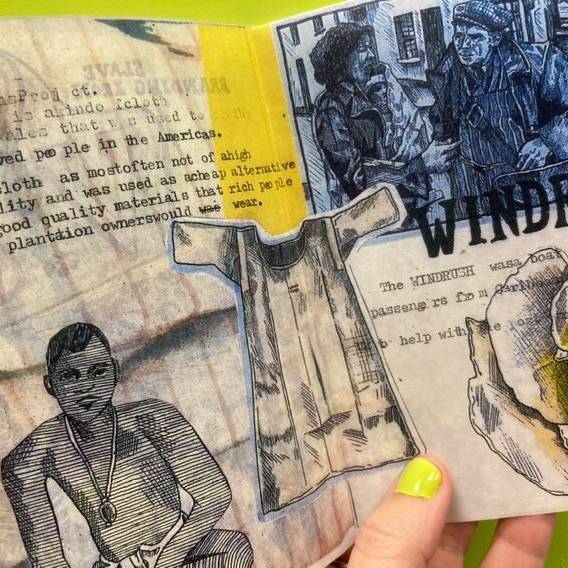Myfyrwyr celf yn creu llyfr ar gysylltiadau diwydiant gwlân Cymru â chaethwasiaeth
Mae myfyrwyr celf Coleg Menai wedi darlunio llyfr sy'n archwilio'r cysylltiadau rhwng y fasnach gaethweision byd-eang a diwydiant gwlân Cymru yn y 18fed a'r 19eg ganrif.
Mae 'Hanesion Plethedig Gwlân Cymru a Chaethwasiaeth' yn cynnwys darluniau gan ddysgwyr sy'n dilyn y cyrsiau BA (Anrh) a gradd sylfaen Celf a Dylunio ym Mharc Menai, Bangor.
Bu’r myfyrwyr Chloe Buckless, Anne Butler, Jessica Chun, Seren Haf Williams-Davies, Elin Roberts a Kimberley Sanchez yn ymchwilio i’r cysylltiadau hanesyddol rhwng y fasnach gaethweision a chynhyrchu gwlân yng Nghymru yn ystod yr un cyfnod.
Mae eu hymatebion gweledol trawiadol yn ymddangos drwy gydol y llyfr dwyieithog sydd ar gael yn rhad ac am ddim, gan ddod â’r stori’n fyw am sut y defnyddiwyd gwlân a elwid yn ‘Welsh Plains’ gan fasnachwyr Prydeinig i brynu a masnachu caethweision Affricanaidd, a hefyd gan berchnogion planhigfeydd i ddilladu caethweision.
Mae'r llyfr hefyd yn taflu goleuni ar yr amodau caled a ddioddefwyd gan weithwyr gwlân Cymreig y bu i dirfeddianwyr a masnachwyr fanteisio ar eu llafur.
Meddai Anne: “Roedd yn hynod ddiddorol darganfod y cysylltiad rhwng yr hen felinau anghofiedig hyn, y mae llawer ohonynt bellach wedi cael eu hadennill gan natur, a’u rhan mewn cynhyrchu gwlân a ddefnyddiwyd i ddilladu caethweision ochr arall i'r Iwerydd. Rydw i'n credu ei bod yn bwysig bwrw goleuni ar yr hanes hwn.
Woven Histories of Welsh Wool and Slavery features illustrations by learners on the BA (Hons) and foundation degree Art & Design courses based at Parc Menai in Bangor.
Students Chloe Buckless, Anne Butler, Jessica Chun, Seren Haf Williams-Davies, Elin Roberts and Kimberley Sanchez researched the historical connections between the slave trade and Welsh wool production of the same period.
Their striking visual responses appear throughout the free bilingual book, bringing to life the story of how woollens known as ‘Welsh plains’ were used by British merchants to purchase and trade in African captives, and also by plantation owners to clothe enslaved labourers.
The book also sheds light on the harsh conditions endured by Welsh wool workers whose labour was exploited by landowners and merchants.
Anne said: “It was fascinating to find out the connection between these old forgotten mills, many of which are now being reclaimed by nature, and their part in the production of wool that was used to clothe enslaved people across the Atlantic. I think it is important to shed light on this history.
Woven Histories of Welsh Wool and Slavery features illustrations by learners on the BA (Hons) and foundation degree Art & Design courses based at Parc Menai in Bangor.
Students Chloe Buckless, Anne Butler, Jessica Chun, Seren Haf Williams-Davies, Elin Roberts and Kimberley Sanchez researched the historical connections between the slave trade and Welsh wool production of the same period.
Their striking visual responses appear throughout the free bilingual book, bringing to life the story of how woollens known as ‘Welsh plains’ were used by British merchants to purchase and trade in African captives, and also by plantation owners to clothe enslaved labourers.
The book also sheds light on the harsh conditions endured by Welsh wool workers whose labour was exploited by landowners and merchants.
Anne said: “It was fascinating to find out the connection between these old forgotten mills, many of which are now being reclaimed by nature, and their part in the production of wool that was used to clothe enslaved people across the Atlantic. I think it is important to shed light on this history.
“Cododd y prosiect rai teimladau cryf a gafodd eu sianelu i’n celf.”
Roedd gwlân yn ganolog i ddiwydiant tecstilau byd-eang y 18fed ganrif, cyn iddo gael ei oddiweddyd yn y pen draw gan gotwm.
Roedd ‘Welsh Plains’ yn frethyn gwlân gwydn a wehyddwyd yng nghanolbarth Cymru rhwng 1650 a 1850, a oedd mewn galw’n arbennig gan berchnogion planhigfeydd. Ysgrifennodd un plannwr o Dde Carolina, Robert Maxwell, ym 1823 fod gweithgynhyrchwyr lleol wedi ceisio efelychu'r 'Welsh Plains' ond wedi canfod bod rhinweddau eu cynnyrch yn israddol. Roedd yn well gan Maxwell brynu brethyn “a wnaed gan ffermwyr Cymru”.
Mae 'Hanesion Plethedig Gwlân Cymru a Chaethwasiaeth' yn rhan o brosiect ymchwil a arweiniwyd gan Dr Charlotte Hammond o Brifysgol Caerdydd, mewn cydweithrediad ag ymchwilwyr cymunedol Liz Millman (Learning Links International) a Marcia Dunkley (Black Heritage Walks Network).
Dywedodd Dr Hammond: “Gyda’r prosiect hwn, rydyn ni wedi ceisio tynnu sylw at ddarn o hanes nad yw wedi cael llawer o gydnabyddiaeth hyd yn hyn.
“Archwiliodd y myfyrwyr olion o’r naratif hanesyddol hwn sy’n cysylltu ecsbloetio gwehyddion yng nghefn gwlad Cymru ag anghyfiawnder hiliol caethwasiaeth yr Iwerydd, a’i ddibyniaeth ar gylchrediad tecstilau Cymreig.
“The project brought up some strong feelings which could be channelled into our art.”
Wool was at the centre of the global textile industry of the 18th century, before it was eventually overtaken by cotton.
‘Welsh Plains’ was a durable woollen cloth woven in mid-Wales between 1650 and 1850, which was particularly sought-after by plantation owners. One South Carolina planter, Robert Maxwell, wrote in 1823 that local manufacturers had tried to imitate Welsh Plains but found their products’ qualities to be inferior. Maxwell preferred to buy cloth “made by the farmers of Wales”.
Woven Histories of Welsh Wool and Slavery is part of a research project led by Dr Charlotte Hammond of Cardiff University, in collaboration with community researchers Liz Millman (Learning Links International) and Marcia Dunkley (Black Heritage Walks Network).
Dr Hammond said: “With this project, we have sought to highlight an area of history that has received little recognition until now.
“The students explored traces of this historical narrative that links the exploitation of weavers in rural Wales with the racial injustices of Atlantic slavery, and its reliance on the circulation of Welsh-made textiles.
“The project brought up some strong feelings which could be channelled into our art.”
Wool was at the centre of the global textile industry of the 18th century, before it was eventually overtaken by cotton.
‘Welsh Plains’ was a durable woollen cloth woven in mid-Wales between 1650 and 1850, which was particularly sought-after by plantation owners. One South Carolina planter, Robert Maxwell, wrote in 1823 that local manufacturers had tried to imitate Welsh Plains but found their products’ qualities to be inferior. Maxwell preferred to buy cloth “made by the farmers of Wales”.
Woven Histories of Welsh Wool and Slavery is part of a research project led by Dr Charlotte Hammond of Cardiff University, in collaboration with community researchers Liz Millman (Learning Links International) and Marcia Dunkley (Black Heritage Walks Network).
Dr Hammond said: “With this project, we have sought to highlight an area of history that has received little recognition until now.
“The students explored traces of this historical narrative that links the exploitation of weavers in rural Wales with the racial injustices of Atlantic slavery, and its reliance on the circulation of Welsh-made textiles.
“Mae ein gwaith wedi mynd â ni o adfeilion melinau pandy yn Nolgellau, Meirionnydd, ar hyd llwybrau'r ceffylau pwn oedd yn cludo brethyn 'Welsh Plains' i Loegr. Yno, byddai'n cael ei liwio a'i orffen yn Amwythig, ei anfon i Lundain a Lerpwl i'w fasnachu ac yna ei allforio i America.
“Rydyn ni wedi olrhain cysylltiadau trefedigaethol y lliain i'r Caribî a thaleithiau de’r Unol Daleithiau, lle defnyddiwyd 'Welsh Plains' i ddilladu caethweision a weithiai ar y planhigfeydd.
“Daw ymateb weledol i’r hanes hwn i'r amlwg yng ngwaith celf y grŵp o artistiaid a dylunwyr newydd hyn.”
Mae 'Hanesion Plethedig Gwlân Cymru a Chaethwasiaeth', a gyhoeddwyd gan Common Threads Press, ar gael ar-lein a bydd hefyd yn cael ei gyhoeddi mewn print yn ddiweddarach eleni. Cefnogwyd y llyfr gan Gyllid Arloesi Ymchwil Cyngor Cyllido Addysg Uwch Cymru (CCAUC).
Mae gwaith celf y myfyrwyr hefyd wedi cael ei arddangos ym Mhrifysgol Caerdydd fel rhan o’r prosiect.
Am ragor o wybodaeth am y cyrsiau Celf a Dylunio sydd ar gael yng Ngrŵp Llandrillo Menai cliciwch yma.
“Our work has taken us from the ruins of pandy-fulling mills in Dolgellau, Meirionnydd, via the packhorse trails that transported Welsh Plains cloth to England. There, it was dyed and finished in Shrewsbury, sent to London and Liverpool to be traded and then exported to the Americas.
“We have followed the cloth’s colonial connections to the Caribbean and southern states of the US, where Welsh Plains was used to clothe enslaved field workers who toiled on the plantations.
“The resulting artwork from the group of emerging artists and designers is their visual response to this history.”
Woven Histories of Welsh Wool and Slavery, published by Common Threads Press, is available online and will also be published in print later this year. It has been supported by Higher Education Funding Council for Wales (HEFCW) Research Innovation Funding.
Students’ artwork has also been on display at Cardiff University as part of the project.
For more information about the art and design courses available at Grŵp Llandrillo Menai, click here.
“Our work has taken us from the ruins of pandy-fulling mills in Dolgellau, Meirionnydd, via the packhorse trails that transported Welsh Plains cloth to England. There, it was dyed and finished in Shrewsbury, sent to London and Liverpool to be traded and then exported to the Americas.
“We have followed the cloth’s colonial connections to the Caribbean and southern states of the US, where Welsh Plains was used to clothe enslaved field workers who toiled on the plantations.
“The resulting artwork from the group of emerging artists and designers is their visual response to this history.”
Woven Histories of Welsh Wool and Slavery, published by Common Threads Press, is available online and will also be published in print later this year. It has been supported by Higher Education Funding Council for Wales (HEFCW) Research Innovation Funding.
Students’ artwork has also been on display at Cardiff University as part of the project.
For more information about the art and design courses available at Grŵp Llandrillo Menai, click here.






